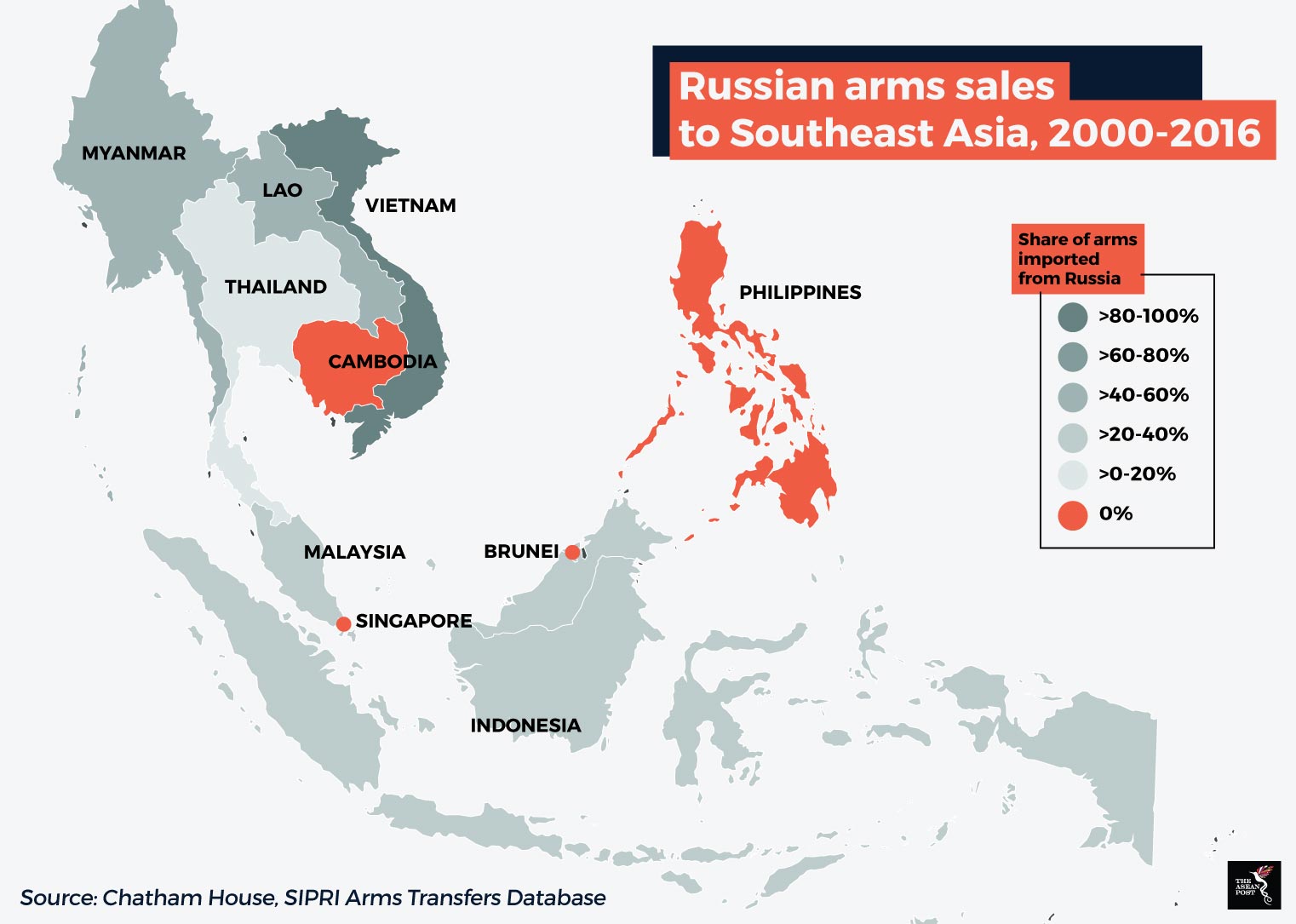The bedrock of Russia’s relations with Southeast Asian countries is the sale of its arms. According to a Chatham House report in 2017, Russia exports 43.1 percent of its weapons to Asia and Association of Southeast Asian Nations (ASEAN) member states are key recipients of these arms.
Even for smaller countries like Myanmar, that don’t make up a large share of the Russian arms exports market, Russia is still the main supplier of weapons to the state. In this case, Myanmar only represents a meagre 1.4 percent of Russia’s total arms exports.
Away from the arms of the West
Southeast Asian states which have for long looked towards the United States (US) for weapons supplies are now either shifting or hedging their imports by turning to Russia. Russia has also made significant inroads into countries like Indonesia, the Philippines and Malaysia for its arms sales.
One of Russia’s significant achievements is to slowly chip away at the Philippines’ dependence on US arms. Under the administration of President Rodrigo Duterte, this has slowly come to fruition.
Duterte, was especially in need of such supplies as his forces battled terrorists attempting to siege the southern Philippine city of Marawi. In the aftermath of the victory against the insurgents, Duterte thanked Russia’s “timely” aid of weapons and trucks at the side-lines of the Asia Pacific Economic Summit in Vietnam last November. According to Duterte, these supplies helped “turn the tide” of the crisis as the Philippines forces were short of arms.
President Duterte is now looking towards Russian weapons to help bolster the Philippines defences. In 2016, Duterte’s order of 26,000 weapons from the US was scrapped because it failed to gain approval from the US Congress for fears that it may be used for extrajudicial killings in his drug war. However, Russian weapons purchases come with lesser strings attached.
Russian destroyers also visited the Philippines three times in 2017. During the last visit, Russia donated 5,000 units of AK-74M Kalashnikov assault rifles, one million pieces of ammunition, 5,000 steel helmets, and 20 multi-purpose trucks to the Philippines.

Malaysia has also been keen on expanding bilateral weapons understanding with Russia. The Southeast Asian state is a key customer for Russian aircrafts owing to its fleet of Russian MiGs and Sukhois.
In Indonesia, Russia accounted for 20 percent of the country’s arms imports from 2000 to 2016. It was recently announced that Jakarta inked a US$1.14 billion deal to buy 11 Russian Sukhoi Su-35 jets. This purchase comes on the heels of a memorandum of understanding (MoU) signed between the two countries in August 2017 to exchange jets for key commodities. Hence, Russia is expected to import Indonesian palm oil, coffee and tea in exchange for its jets. According to Agence France Presse (AFP), the deal is a move by Indonesia to capitalise on Western sanctions imposed on Russia.
Rustling Chinese feathers
Russian weapons have one key advantage over US weapons. They’re cheaper. Given that Southeast Asian nations don’t have deep pockets when it comes to defence budgets, Russian arms are often seen as the more attractive choice.
However, as Moscow continues to stamp its ground on the Southeast Asian arms market, it risks infuriating China.
One of Russia’s main export destinations within Asia besides China and India is Vietnam which imported 10 percent of Russia’s total arms exports between 2010 and 2016. This presents a problem as Vietnam alongside China and another four countries are claimants to maritime features in the South China Sea. The overlap between Vietnamese and Chinese claims have seen regular military tiffs in the past.
For a long time, Moscow and Beijing have been strategic partners but as Russia continue to supply submarines and frigates to Vietnam, it could harm that partnership. Nevertheless, it does serve as a useful deterrent for Russia to China’s growing influence.
Recommended stories:
